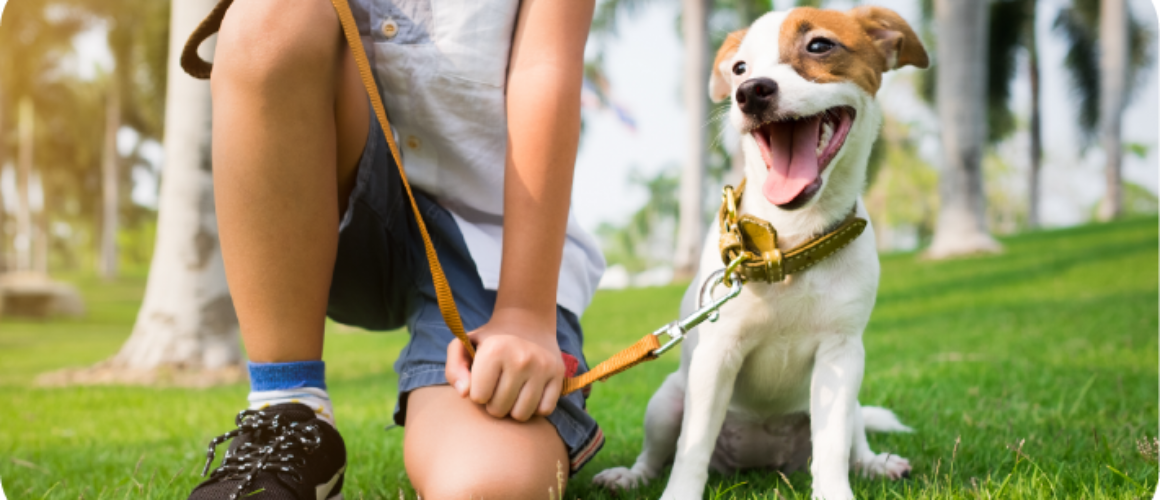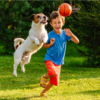What To Do When You Meet an Unfamiliar Dog
Many dogs will be friendly towards unfamiliar people and will not show any signs

Many dogs will be friendly towards unfamiliar people and will not show any signs of aggression when approached, but there may be some who will behave aggressively if someone approaches too closely.
Why are dogs aggressive?
Dogs are aggressive in response to unfolding events and it always depends on what they believe is happening to them. When dogs use aggression it is almost always because they think that they are under some form of threat. For example, the threat could be to their personal safety, to take away something or someone they value highly, or they may feel their territory is threatened.
Being able to recognise the signs of aggression and knowing how to behave around dogs that show these behaviours can help you make them feel less threatened and reduce the chance of aggression towards you. For more information see What to do when you meet an unfamiliar dog (pdf 1.15 MB).
The leaflet is based on the RSPCA¿s dog aggression FAQs with information provided by David Ryan, Chairman of the Association of Pet Behaviour Counsellors. The advice offered in these FAQs is recognised by the Association for the Study of Animal Behaviour Accreditation Committee as reflecting what is accepted as good practice by those working in the field of clinical behaviour in companion animals.
See our canine aggression FAQs for more information about dog aggression.
Understanding dog behaviour
The way a dog behaves depends on the dog’s age, breed (or type), personality and past experiences. Make sure your dog is able to behave normally.
Ensure your dog is able to behave normally
Our top tips to help your dog behave normally
- Choose a type and size of dog that is suited to you, your home and your lifestyle.
- Train your dog from an early age to behave well using rewards. Training a dog using rewards will help them learn to behave appropriately and make them easier to control. Good training can enhance a dog’s quality of life and your relationship with them. Find out more about establishing a good relationship with your dog.
- Teaching your dog where to toilet is really important.
- If you’re concerned about your dog’s behaviour, speak to your vet first who may then refer you to an animal behaviourist.
- Never shout at or punish your dog. Punishment and frightening experiences can lead to behaviour problems and suffering. Be consistent in the way you, your family and friends react to your dog.
- Frightening experiences and punishment can lead to behaviour problems and suffering. Be consistent in the way you, your family and friends react to your dog.
- A dog needs regular exercise and plenty of opportunities to walk and run. Exercise your dog regularly to keep them fit, active and stimulated. Give your dog the opportunity to run every day, unless your vet recommends otherwise.
- Dogs are playful, sociable animals. Give your dog safe toys and regular opportunities to play with people or other friendly dogs. Make sure they have enough to do so that they don’t become distressed or bored.
- A dog must be able to avoid things that scare them. Give your dog constant access to a safe hiding place where they can escape when they feel afraid.
- Be observant. If your dog’s behaviour changes or they show regular signs of stress or fear (such as excessive panting, licking lips, hiding, cowering, aggression), seek advice from a vet or clinical animal behaviourist. They could be distressed, bored, ill or injured.
Understanding dog behaviour
You need to be observant to recognise any changes in your dog’s behaviour. Use this guide to help you recognise important body language signals and get to know how your dog is feeling.
If you’re concerned about your dog’s behaviour speak to your vet first who may then refer you to a clinical animal behaviourist.
View the dog behaviour infographic.
A dog who is happy will be relaxed
1. Dog has a relaxed body posture, smooth hair, mouth open and relaxed, ears in natural position, wagging tail, eyes normal shape.
2. Dog is inviting play with bottom raised, smooth hair, high wagging tail, eyes normal shape, ears in natural position, may be barking excitedly.
3. Dog’s weight is distributed across all four paws, smooth hair, tail wagging, face is interested and alert, relaxed and open mouth.
These dogs are telling you that they’re uncomfortable and don’t want you to go near them.
1. Dog is standing but body posture and head position is low. Tail is tucked under, ears are back and dog is yawning.
2. Dog is lying down and avoiding eye contact or turning head away from you and lip licking and ears are back.
3. Dog is sitting with head lowered, ears are back, tail tucked away, not making eye contact, yawning, raising a front paw.
These dogs aren’t happy and want you to stay away or go away.
1. Dog is standing with a stiffened body posture, weight forward, ears are up, hair raised, eyes looking at you ¿ pupils dark and enlarged, tail is up and stiff, wrinkled nose.
2. Dog is lying down cowering, ears flat, teeth showing, tail down between legs.
3. Dog is standing with body down and weight towards the back, head is tilted upwards, mouth tight, lips drawn back, teeth exposed, eyes staring, ears back and down, snarling.
Barking dogs – what can I do?
Dogs bark for many different reasons. A dog may bark to express how they are feeling – for example, when they are excited, frustrated, bored or scared. If a dog feels threatened they may bark to tell somebody to stay away or leave.
Other times, dogs may bark because they want something in particular, such as their favourite toy. Dogs may also bark when they are in distress – for example – when they are left alone.
Barking is a form of communication and is a completely normal dog behaviour. However, if the amount your dog barks increases or becomes excessive it can be a sign that something isn’t right and it may cause problems for other people. If this happens it’s important to address any underlying problems which could be causing your dog to bark more.
My dog has started barking a lot more than usual
If your dog is barking excessively or more than usual, there may be an underlying health issue – for example, any problems with your dog’s hearing which could be causing the barking. If you suspect your dog’s hearing is suffering speak to your vet.
My dog barks when left alone
If your dog is barking when you’re not around they may be experiencing distress when you are not present. Separation related behaviour or separation anxiety can show itself in a number of ways including barking. The good news is that there are things you can do to help, as well as determine what the cause of the barking may be.
My dog barks at visitors or passers-by
Some dogs will bark at people passing by your house or garden. You can try preventing your dog from seeing anybody passing the house by reducing access to windows or gardens.
It’s a good idea to have tasty treats and exciting toys to hand – you can use these to distract your dog should they hear somebody and then start to feed/play once your dog has become quiet. It’s best to seek the help of a dog trainer or behaviour expert if your dog is behaving in this way – they can put a training plan in place to reduce the behaviour.
Ways to help stop your dog barking excessively:
Prevent boredom – dogs are intelligent, active and social animals so they need lots of exercise, things to do and company to keep them happy and healthy. If your dog is bored they might spend more time barking. Make sure your dog has enough to do every day to stop them getting bored.
- Establish a good routine – Your dog may be barking to communicate they want to play, or that they want food or attention. Make sure that you have a daily routine in place for your dog which includes meal times, play and exercise, at around the same time each day. A good routine can help your dog to know what and when activities are going to happen and may help stop them barking for activities at other times!
- Dogs bark for so many different reasons and so it’s necessary to discover what the cause for their barking is. Asking for advice from an expert can help you understand what is causing the behaviour and they will be able to point you in the right direction for help. For expert help, contact a qualified dog behaviourist who will be able to put a treatment plan together for you and your dog.
Find a clinical animal behaviourist near you
Reporting a barking dog
The occasional bark or ‘woof’ is usually not a problem for neighbours and others in the community but when barking becomes disruptive it’s often considered unacceptable and unpleasant to many people.
If you’re concerned about a dog barking excessively near you there are things you can do:
- Speak to the owner. They may not be aware there’s an issue, or they may be using some of the advice above to try and resolve the issue.
- If speaking to your neighbour hasn’t worked or isn’t an option, try contacting your local council about the noise complaint. This can help resolve the underlying issue, or if there is a welfare complaint they will contact us. Contact your local council about a barking dog
What is dog aggression?
Aggression is a normal part of the way animals behave. Often people only consider aggressive behaviour in dogs to be a problem when it reaches biting, but it can include lesser degrees, such as ‘grumbling’, growling, snarling, teeth-baring and snapping at the air without making contact. Bites too can vary from light touches with the teeth through to inflicting serious injury.
Aggression is the outward expression of an emotion and can be used to communicate various intentions. Rather than being something that switches on and off suddenly, aggression is part of a range of behaviours that dogs have available to them to deal with life’s challenges.
Many of these behaviours are passive and it is only when the dog changes from trying to avoid a situation, through things like moving away or showing that they aren’t happy, to actively trying to manage the situation, that we term it ‘aggression’. When a dog has to cope with a particular feature of its life it has a number of options available to it. Aggression is simply a part of some of those options.
FAQ’s
For answers to the most common FAQ’s about dog aggression see: Canine aggression FAQs (PDF 258 KB)
The information within these FAQs has been provided by David Ryan, a Clinical Animal Behaviourist certified by the Association for the Study of Animal Behaviour. The advice offered in these FAQs is recognised by the ASAB Accreditation Committee as reflecting good practice by those in the field of clinical behaviour in companion animals.
The Association for the Study of Animal Behaviour (ASAB) is the leading professional society in the UK for the study of animal behaviour. Certification, which is administered by the ASAB Accreditation Committee, is the means by which ASAB demonstrates to the public and to other professions, that certain individuals meet the educational, experiential and ethical standards required by the Society of a professional clinical animal behaviourist.
The APBC, founded in 1989, is an international network of experienced and qualified pet behaviour counsellors who work on referral from veterinary surgeons to treat behaviour problems in dogs, cats, birds, rabbits, horses and other pets.







